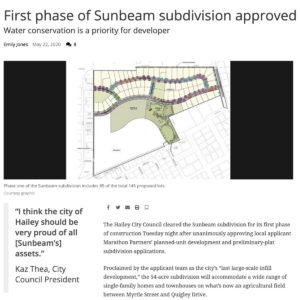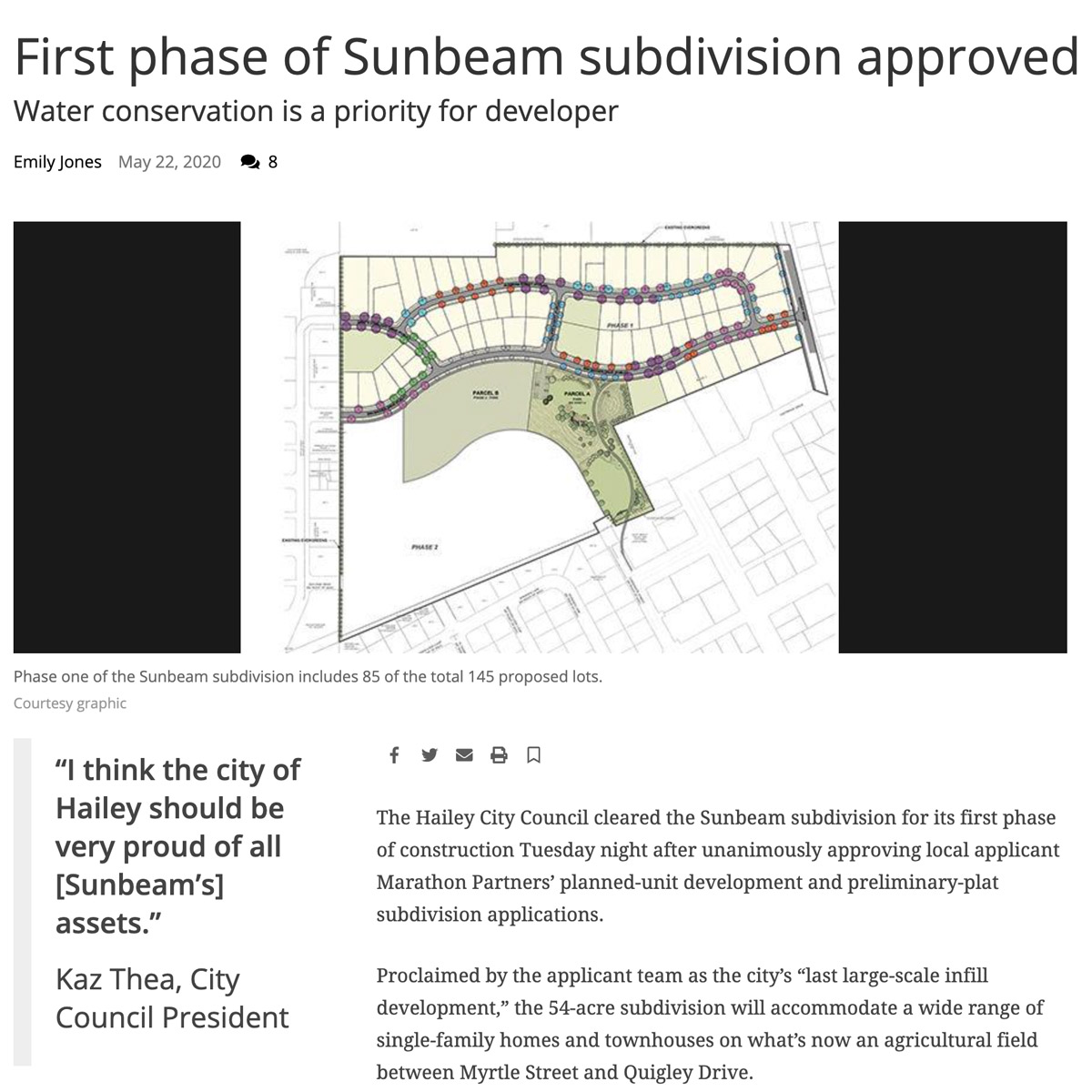 First phase of Sunbeam subdivision approved
First phase of Sunbeam subdivision approved
Water conservation is a priority for developer
Emily Jones
The Hailey City Council cleared the Sunbeam subdivision for its first phase of construction Tuesday night after unanimously approving local applicant Marathon Partners’ planned-unit development and preliminary-plat subdivision applications.
Proclaimed by the applicant team as the city’s “last large-scale infill development,” the 54-acre subdivision will accommodate a wide range of single-family homes and townhouses on what’s now an agricultural field between Myrtle Street and Quigley Drive.
The neighborhood will feature a diverse collection of lot sizes averaging about 9,925 square feet. While the subdivision was originally configured to hold 108 lots, the applicant team—at the request of the City Council—increased its density to 145 lots by dividing half-acre lots, shifting cottage lots and distributing smaller lots throughout the property. Most lots have been narrowly sliced to allow for front-facing porches and private backyards, landscape architect Ben Young said, to foster both a sense of community and privacy
The Sunbeam concept is largely based around energy and water conservation, project attorney Ed Lawson said during a council presentation Tuesday. To help achieve National Green Building Standard certification, 60 to 70 percent of the land area of each residential lot will be either drought tolerant or hardscaped with stone to reduce watering needs, and residents will need to follow regulations limiting time-of-day watering, chemical use and species of grass planted. For those living on lots over 14,000 square feet, only 25 percent of their total land area can be turf, according to the Sunbeam development agreement.
One newer—and well-received—development shared ahead of the council verdict Tuesday was the developer’s plan to install solar wiring on every roof for future paneling.
“The higher density, the cottage lots, the solar power for houses—these are all great new things I don’t think we see in any other development,” Councilman Sam Linnet said.
Council President Kaz Thea agreed.
“I’m ready to move forward with this subdivision. I think the city of Hailey should be very proud of all of the assets from this handsome-looking, diverse development,” she said.
One key project amenity is its planned 9.14-acre public park—set to be the city’s largest—which will border Curtis Park and offer paved bike-path connections to Quigley Road and Old Cutters subdivision. The park will also feature passive-play equipment for children, such as boulders and woody structures, native grasses and shrubbery, and a hill for winter sledding.
“Bike-trail connectivity will be greatly improved, as people will finally be able to travel through this [to-be] former field area,” Lawson said. “Six connections to existing streets will also facilitate connectivity.”
In terms of water connections, the developer has elected to connect to the municipal potable water system rather than a private irrigation system. Lawson said that will likely have a “slight” impact on water supply in the area, but shouldn’t raise concern.
“There will be a 2 percent pressure loss for potable water service in the area, but that does not fall below the state water pressures standards,” he said.
To reduce the subdivision’s impact on the municipal system, the developing team offered the city a $200,000 cash contribution toward building a new well on-site. On Tuesday, the council was presented with an alternative offer—instead of the $200,000 contribution, the developer could transfer 30 acres of water rights to the city that could be used any time in the future.
Each council member voted in support of the alternative.
“The longer-term benefits of the water rights is a better deal in my opinion,” Linnet said. “Water rights are always the right way to go—$200,000 comes and goes, but water rights last.”
A well is still scheduled to be constructed on-site to offset water-pressure changes in the vicinity. On Tuesday night, the council concluded that the best well site was an area south of the Sunbeam park, where a cottage lot had previously been placed.
Lawson also briefly addressed the impacts the subdivision would have on nearby intersections.
“The traffic impacts are negligible. There are no material adverse impacts on the level of service at any intersection,” he said. “And there has been no substantial public opposition to the project.”


